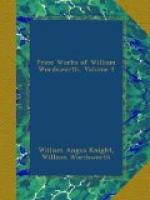The channel of the Greta, immediately above Keswick, has, for the purposes of building, been in a great measure cleared of the immense stones which, by their concussion in high floods, produced the loud and awful noises described in the sonnet.
‘The scenery upon this river,’ says Mr. Southey in his Colloquies, ’where it passes under the woody side of Latrigg, is of the finest and most rememberable kind:
——“ambiguo
lapsu refluitque fluitque,
Occurrensque sibi venturas
aspicit undas."’
390. Brigham Church.
‘By hooded votaresses,’ &c. (VIII. l. 11).
Attached to the church of Brigham was formerly a chantry, which held a moiety of the manor; and in the decayed parsonage some vestiges of monastic architecture are still to be seen.
391. *_Nun’s Well, Brigham_. [VIII.]
So named from the Religious House which stood close by. I have rather an odd anecdote to relate of the Nun’s Well. One day the landlady of a public house, a field’s length from it, on the road-side, said to me, ‘You have been to see the Nun’s Well, sir.’ ’The Nun’s Well! What is that?’ said the postman, who in his royal livery stopt his mail-car at the door. The landlady and I explained to him what the name meant, and what sort of people the nuns were. A countryman who was standing by rather tipsy stammered out, ’Ay, those Nuns were good people; they are gone, but we shall soon have them back again.’ The Reform mania was just then at its height.
392. *_To a Friend_. [IX.]
‘Pastor and Patriot.’
My son John, who was then building a parsonage on his small living at Brigham.
393. Mary Queen of Scots landing at Workington. [X.]
‘The fears and impatience of Mary were so great,’ says Robertson, ’that she got into a fisher-boat, and with about twenty attendants landed at Workington, in Cumberland; and thence she was conducted with many marks of respect to Carlisle.’ The apartment in which the Queen had slept at Workington Hall (where she was received by Sir Henry Curwen as became her rank and misfortunes) was long preserved, out of respect to her memory, as she had left it; and one cannot but regret that some necessary alterations in the mansion could not be effected without its destruction.
394. *_Mary Queen of Scots_.[X.]
‘Bright as a star.’
I will mention for the sake of the friend who is writing down these Notes that it was among the fine Scotch firs near Ambleside, and particularly those near Green Bank, that I have over and over again paused at the sight of this image. Long may they stand to afford a like gratification to others! This wish is not uncalled for—several of their brethren having already disappeared.
N.B. The Poem of St. Bees to follow at this place.
395. St. Bees and Charlotte Smith. [XI.]
St. Bees’ Heads, anciently called the Cliff of Baruth, are a conspicuous sea-mark for all vessels sailing in the N.E. parts of the Irish Sea. In a bay, one side of which is formed by the southern headland, stands the village of St. Bees; a place distinguished, from very early times, for its religious and scholastic foundations.




